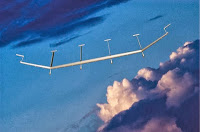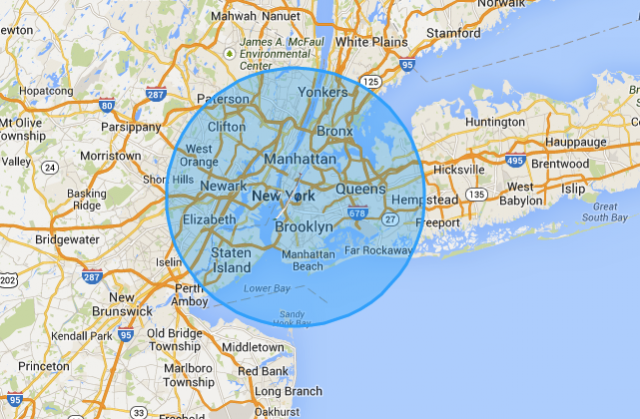 |
| DARPA’s Vulture Program Boeing 400-foot prototype Solar Eagle |
Nicholas West
Activist Post
As you will read below, I had previously reported on Facebook’s interest in Titan Aerospace, a solar drone company that could presumably facilitate a truly World Wide Web that would cover the globe with a blanket of aerial communication.
It now appears that Google has taken the lead, purchasing the company for what some speculate is more than the initial price of $60 million dollars that was being considered by Facebook.
Business Insider has provided some of the known details about how Google might use this new acquisition:
It sounds like Titan will work on a variety of projects for Google.
- Titan will be able to collect photos from around the planet from high up, which could help with Google Earth and Google Maps. (and facial recognition – Ed.)
- It will also contribute to Google’s Project Loon, which is sending balloons into the atmosphere which then beams Internet to parts of the world that are not yet connected.
- It’s also likely to work with Makani, another company Google bought, that gets wind power high in the sky, and delivers the energy back to earth through a long cable. (Source)
Added to the background of what we know about Facebook’s plans and the move toward solar drones in general, Google’s purchase indicates that much of the speculation is likely to become reality.
(Additional note: DARPA also has begun research into using drones as wireless hotspots for military applications.)
Facebook Interested in Solar Drones For Global Internet
Even as the debate intensifies over the scope of drone warfare and surveillance, significant upgrades continue and the drone industry booms. The trend is toward a future of autonomous fleets of large-scale war fighters combined with increasing miniaturization that will make drone tech part of the fabric of our everyday lives.
The latest developments focus on ways to not only get these new drone models aloft via remote control, or through their own autonomous decisions, but how to keep them there for as long as possible – perhaps even permanently – by harvesting power from the environment.
Titan Aerospace was the first to introduce the concept of a solar drone, as you’ll see in the video below. The ability to potentially blanket the Earth with a permanent drone presence to send and receive data has now caught the attention of Facebook which, reports indicate, seek to acquire Titan in a possible $60 million purchase.
First a bit of history to illustrate how military tech trickles down into the consumer market. It is especially important to understand in light of the NSA surveillance revelations and how closely aligned the world’s largest tech companies are to Big Brother government across the world.
Toward the end of 2011 a program called MUSIC was made public and revealed the goals of Future Combat Systems – essentially a network of ground-based and sky-based systems that could communicate and operate as a seamless and permanent intranet of war and surveillance.
 Since that time, the technology has been publicly rolled out demonstrating the capability for drones to stay aloft for increasing periods of time. This was revealed in a drone industry report provided by Aerospace and Defense News covering plans for 2013-2023, where it states:
Since that time, the technology has been publicly rolled out demonstrating the capability for drones to stay aloft for increasing periods of time. This was revealed in a drone industry report provided by Aerospace and Defense News covering plans for 2013-2023, where it states:
Laser-powered UAVs are powered by a laser transmitter which converts power from a primary source, such as a battery, generator or AC powerline, into a single-wavelength beam of light. These UAVs are capable of staying airborne for their entire lifecycle as this method of recharging avoids the need to land and refuel, which may also improve the lifecycle and maintenance costs as much of the damage incurred by UAVs occurs while landing. (Source)
It is important as a related note that these drones eventually will be equipped with the latest in biometric capabilities, namely facial recognition, as was announced in the following Associated Press article:
From seeing just the image of a face, computers will find its match in a database of millions of driver’s license portraits and photos on social media sites. From there, the computer will link to the person’s name and details such as their Social Security number, preferences, hobbies, family and friends.
Adding that capability to drones that can fly into spaces where planes cannot — machines that can track a person moving about and can stay aloft for days — means that people will give up privacy as well as the concept of anonymity. (Source) [emphasis added]
The fact that what used to be conspiracy talk is now openly discussed in corporate media as we head toward a full implementation of drones over the U.S. by 2015 is likely not a coincidence.
This is the backdrop as we enter the arena of solar-powered drones that Facebook is interested in acquiring.
CBS News reported in October of last year that Titan Aerospace has developed its Solara line of drones which can fly continuously for up to five years.
The larger Solara will be 60 meters wide and have the ability to carry about 250 pounds.
Cruising speed for the Solara is about 65 mph, and the unmanned craft will have an operating range of over 2.8 million miles.
The Solara series are designed to be a fraction of the cost of a satellite, but operate many similar tasks, such as surveillance, crop-monitoring, weather and disaster oversight, or any other monitoring that low-altitude satellites track.
[…]
Titan Aerospace is based out of New Mexico, and a report from Breaking Defense finds that defense and intelligence customers such as the CIA, NRO and NGA are the most obvious interested buyers. The company has reportedly held preliminary talks with intelligence agencies about the use of the Solara aircraft. (Source) [emphasis added]
Here is the promo video:
The solar concept is also being offered as the next gen tech to be applied to already existing micro drones that are designed to mimic nature. In May of last year, I covered the announcement of a 3D printed drone called Robo Raven that utilizes 3D-printed components to produce a first of its kind: independently flapping wings.
The new version of Robo Raven features solar cells added to its wings:
Because Robo Raven’s large wings have enough surface area to create a usable amount of solar energy, the team decided to incorporate flexible solar cells into them. The captured solar energy is then used to supply Robo Raven’s onboard batteries. “These new multi-functional wings will shape the future of robotic birds by enabling them to fly longer, farther, and more independently because they will be getting their power from the sun” says ME Ph.D. student Luke Roberts, a member of the Robo Raven team. (Source)
As noted by Ars Technica, the concept of solar powered flying machines has existed since the late 1970s, but just now is being incorporated into drone tech in an effective way. And lest anyone believe that this technology is not intended for full use over the United States, an interesting map is offered in the Ars Technica article linked above showing the range of the solar drone, Solara 50.
Ars concludes as follows:
Titan already has customer reservations for the first three of its Solara drones, two of which are intended to serve as communications relays (though the customer has not been identified). The first will be delivered in February, with manufacturing ramping up for monthly delivery starting in April. [emphasis added]
 And here we are currently right within this time frame as the Facebook news makes the rounds. As TechCrunch is reporting, the Internet.org initiative is backed by a handful of telecom companies and Facebook. In the end, Internet.org presents a means of ushering in a single planetary Internet. First, however, it will begin in regions that are currently lacking in traditional infrastructure:
And here we are currently right within this time frame as the Facebook news makes the rounds. As TechCrunch is reporting, the Internet.org initiative is backed by a handful of telecom companies and Facebook. In the end, Internet.org presents a means of ushering in a single planetary Internet. First, however, it will begin in regions that are currently lacking in traditional infrastructure:
From our understanding, Facebook is interested in using these high-flying drones to blanket parts of the world without Internet access, beginning with Africa. The company would start by building 11,000 of these unmanned aerial vehicles (UAVs), specifically the “Solara 60” model. (Source)
When we begin to put the pieces together, we can begin to see the dual-use that could be employed on the back of Facebook’s solar drone infrastructure.
Interestingly, Mark Zuckerberg is invoking “human rights” as part of the sales pitch for Internet.org:
Zuckerberg writes “There are huge barriers in developing countries to connecting and joining the knowledge economy. Internet.org brings together a global partnership that will work to overcome these challenges, including making internet access available to those who cannot currently afford it.” Zuckerberg has laid out his thoughts on accessibility in a paper called “Is Connectivity A Human Right?” (Source) [emphasis added]
I would submit that true human rights should never be imposed. In so doing, what we really are likely to see is a means of getting anyone and everyone into the system which those of us who are already connected are being subjected to: backdoors to violating essential civil liberties and human rights. Secondly, the idea that Facebook will not seek ways to commodify these “human rights” is dubious at best.
The right to remain free (opt out) of government and corporate surveillance are the true human rights at stake here. Both are sure to be threatened if Facebook, the telecom industry, and totalitarian governments bring this concept into reality.
Recently from Nicholas West:
- Dragonfly: World’s Smallest Autonomous Drone Takes Flight
- What Are The Rules In A Robot/Human Society?
- Chicago Residents Get Police Visit Based on Pre-Crime Surveillance List
Updated: 4/15/2014



Be the first to comment on "Google Beats Facebook to Acquire Solar Drone Company"